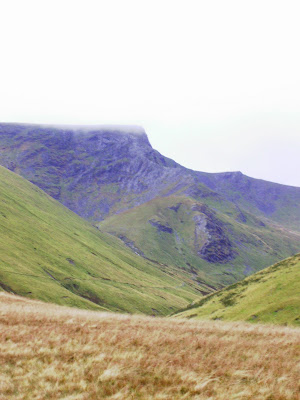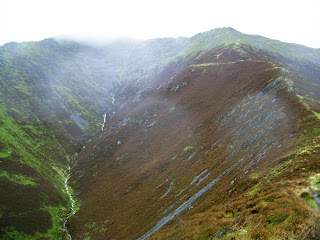I set off up the footpath which went through a wooded area beside Stickle Gill, and followed the path by the steam crossing to the eastern bank a little further up. The slopes leading up to Stickle Tarn looked a glorious golden brown under a shinning sun in the cold crisp air. Above me to my left was was Pike How and to my right were the rocks of Langdale's Tarn Crag. As I continued up the path it began to get rocky and involved some light scrambling. I decided to cross back over the boulder strewn stream, which was flowing deep and fast today. It seemed much more difficult on this occassion, compared to my last crossing at the same point two years earlier.
As I completed the last section of the climb, the grand site of Pavey Ark came into view.
As the ground levelled out Stickle Tarn also came into view along with the wall that runs along the southern edge. I decided to take a rest after the steep ascent, and went to sit on the wall and take in one of the most impressive views in the Lake District.
 |

Straight ahead of me was the massive cliff face of Pavey Ark across Stickle Tarn, and to my left was the eastern shoulder of Harrison Stickle, the highest of the Langdale Pikes. As I sat there, I surveyed the diagonal line of Jack's Rake, starting at the lower right hand side of the Pavey Ark's cliff, going upwards to the left, and ending at the small pinacle. It looked a somewhat formidable sight, and I couldn't help feeling a slight sense of apprehension as I viewed the spectacular rock face. In less that thirty minutes I would be starting this ascent myself.
I made my way around the south-western corner of the tarn, turning off the main path which went up to Harrison Stickle, and followed the bank of the water. As I went on, the dark cliffs of Pavey Ark loomed up overhead across on my left. I veered away from the side of the water and started to climb across the large boulders and scree to the start of Jacks Rake. It seemed rather dark, damp, and cold as I got up close.
 |
| The start of Jack's Rake. Notice the small group just setting out centre right. There is also a lone scrambler part way up. |
I eventually made it to the start of the Rake. I started the initial section which involved a reasonable easy scramble inside a groove in the rock which was about a meter wide. The rock wall of Pavey Ark was too my right, whilst to my left there was a low natural parapet with some vegetation growing on it. It was almost like going up a staircase. Things soon started to get more difficult though. When I first started I could see a group higher up the rake just before the "path" turned round a curve in the rock and went out of sight. They seemed to be hardly moving, and I thought I would soon catch them up. This did not happen though. As I approached this steeper section of the Rake, I found it technically challenging, with suitable foot and hand holes difficult to find as I made my way upwards. Some which I was forced to used seemed to be barely cracks in the rock which I normally would not attempt to use, but this was all there was, and once I had started to climb it was easier to continue up than to retreat back down. I had certainly let myself in for something much more difficult than what I had imagined. It was slow going. I gradually made my way upwards,with each movement carefully thought out and tested in advance, until I made it to a flat ledge above an Ash tree growing out of the cliff below.
This had been the steepest sustained section of the rake. Further along there were more level sections, some along narrow exposed ledges above steep grass slopes that lead down to vertical drops down the crag face. There were still many shorter sections of steep climb which I found rather challenging. One of these was, for me, particularly scary. After traversing one of the level sections of ledge, there was a steep climb that seemed to be just above a vertical drop down to the scree above the tarn. This seemed to be the most exposed section of the rake. I really had to force myself to do this part. I was at this point acutely aware of how high I was on the rock face, and it did feel much more like rock climbing than scrambling.
After negotiating a number of other difficult (although not quite as traumatic) sections, I came round a bend in the rock, and saw a wide rock gully running down the face of the crag, relatively easy to scramble across. I knew at this point that this was Great Gully, and this marked the final section of the Rake. I could see the Pinnacle above, a bit further ahead.
I read in Wainwright that I needed to head for the depression just to its right. To get there I needed to pick my way though sections of rock and vegetation. Finding a way through was more difficult than the photograph above suggests. Once I had crossed the gully and got up close to the rocks, it wasn't obvious which climbs led to ledges from where I could continue climbing safely. At one point I climbed up onto a ledge adjacent to a huge slab of slanting rock. Normally it could have been crossed, but on this occasion it was too wet and slippy to grip. In order to continue it was necessary to climb back down to the lower ledge and use a different route up the rock. Once I had done this I had reached the side of the pinnacle where there was flat rock. This was the end of Jacks Rake. I felt a deep sense of relief to have made it.
From here I made my way over the last sections of rock to the summit of Pavey Ark where I sat down to take in the incredible views.
 |
| Looking across from Pavey Ark summit to Harrison Stickle. |
 |
| Looking from Pavey Ark summit across the ridge leading to Pike o' Blisco to the Coniston Fells. The rocky slope on the right is the east shoulder of Harrison Stickle. |
I have to admit the ascent of Jacks Rake had been a difficult and traumatic climb for me. It had tested my scrambling abilities even though I have had previous experience of rock climbing. It was, however, a fantastic experience, and one which I would very much like to do again. It wasn't until the next day when I truely realised this. But as I sat there on the summit of Pavey Ark, I did at that moment feel emotionally exhausted, despite the fantastic views, which I still managed to appreciate.
I finished the walk by making my way along the path to Harrison Stickle where I spent some time on the summit taking in the views across the Great Langdale Valley. On the descent I took the path above the steep ravine of Dungeon Ghyll, another spectacular sight, before following the path down the steep slope to Pike Howe, and back to the car park at the Stickle Barn.













